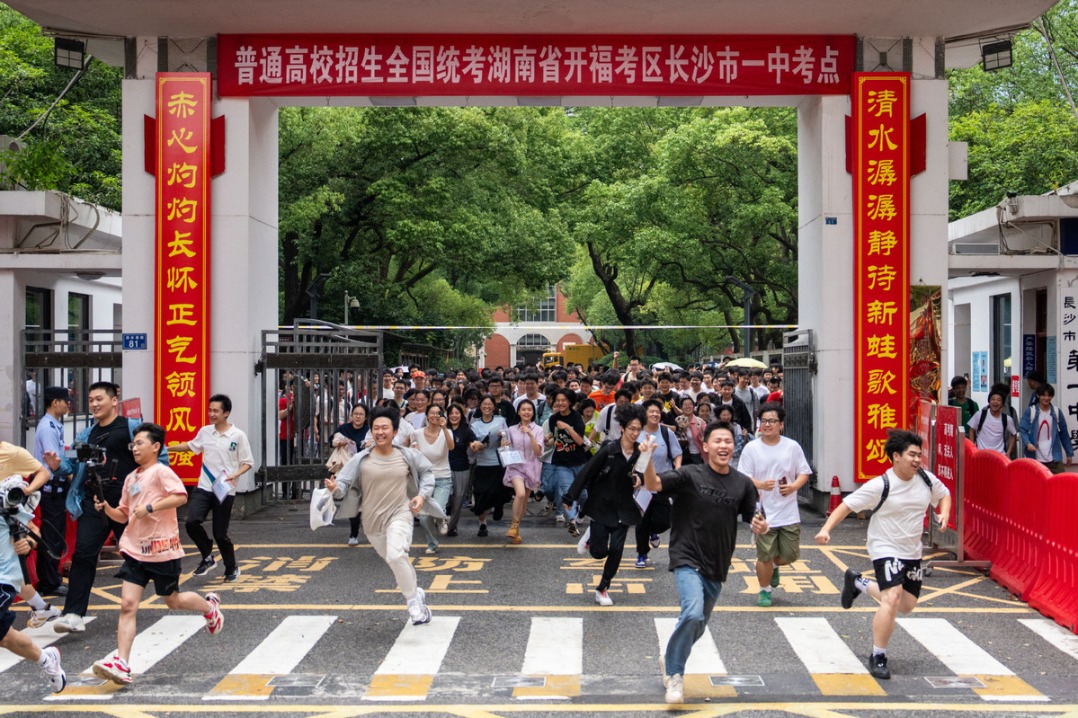Push continues for cleaner waters
Latest action plan targets cutting off pollutants from aquatic ecosystems


China continues to take significant steps forward in protecting water resources, further restricting pollutants discharged in rivers and lakes, and restoring aquatic ecosystems.
The Ministry of Ecology and Environment, together with six other departments, released an action plan in May to develop "beautiful rivers and lakes" across the country.
Covering the period from 2025 to 2027, the plan assigns 19 tasks to improve the water quality and environmental conditions of rivers and lakes.
By 2027, the completion rate of the construction of "beautiful rivers and lakes" should reach about 40 percent, the plan said. By 2035, the whole construction should be basically completed.
These goals were set for the 2,573 rivers and lakes the country selected in 2024 for the "beautiful rivers and lakes" campaign, which was launched in 2021, said Gao Hongjie, head of the Chinese Research Academy of Environmental Sciences' Institute of Water Ecology and Environment.
These waters are located all across the country, and include mainstreams and important branches of major rivers, Gao said, adding that they play an important part in the country's ecosystems.
The plan requires more effective treatment of pollution, saying that the key issues include the operation of facilities collecting and treating sewage in industrial parks, as well as the collection and treatment of initial rainwater in chemical parks.
Authorities should continue to carry out a special campaign to treat water pollution caused by industrial parks in the Yangtze River Economic Belt and along the Yellow River, it said.
The plan calls for better treatment of domestic wastewater in both urban and rural areas, adding that the treatment and recycling of agricultural waste, such as livestock and poultry manure and aquaculture wastewater, should be strengthened.
The plan emphasizes that authorities should ensure an adequate amount of water in rivers and lakes to support their ecosystems, and actively protect and restore the systems.
Water conservancy and hydropower projects must strictly implement the requirements for environmental flow, the plan said, adding that by 2027, the country should complete work to determine and verify environmental flows for its existing large and medium-sized water conservancy and hydropower projects.
China has stepped up its treatment of water pollution over the past decade, and has tasked itself with winning "the battle of protecting clear waters".
From January 2021, a 10-year fishing moratorium began in the Yangtze River.
Zuo Depeng, deputy head of the College of Water Sciences of Beijing Normal University, said the action plan is a milestone in the country's pursuit of turning itself into a "Beautiful China" by 2035.
The plan aims to coordinate the governance of water resources with that of the aquatic environment and aquatic ecology, and marks a transition in the country's water protection efforts from simply controlling and preventing pollution to achieving "harmony between people and water", Zuo said.
Gao also highlighted the plan's holistic approach.
A lower level of pollutants in itself does not necessarily lead to the ecological soundness of waters, Gao said, adding that other factors, such as a sufficient amount of water, habitats and spawning grounds are equally important.
To ensure a tidy environment in rivers and lakes and along their banks, the plan said the use of new energy ships, such as those fueled by green methanol, ammonia and hydrogen, should be promoted, and the collection and treatment of wastewater and garbage from ports, ships and banks should be enhanced.
Greater efforts should also be made to tap into the value of "ecological products" in rivers and lakes and to develop eco-friendly industries.
Wang Jinnan, president of the Chinese Society for Environmental Sciences, said there should be a balance between environmental protection and economic growth.
"Areas along rivers usually have a heavy population and a lot of socioeconomic activities," Wang said in an article published by the Ministry of Ecology and Environment.
These areas should work on the green and low-carbon transition of their people's ways of production and life, and "achieve socioeconomic growth that is in harmony with local population, resources and environment".
"We should turn regions along beautiful rivers and lakes into a new land for high-quality development, and build a good ecological environment to support high-quality development," said Wang, who is also an academician of the Chinese Academy of Engineering.
The plan calls for collaboration between upper and lower reaches, between both sides of rivers and between main streams and branches, and encourages the establishment of an eco-compensation mechanism that covers both environmental protectors at upper reaches and beneficiaries at lower reaches.
Such collaboration is essential for completing the task of developing "beautiful rivers and lakes", according to Zuo. "We won't be able to address complicated and basin-wide issues through fragmented measures. We can only achieve the goal by taking basin-wide actions," he said.
The central government will provide active fiscal support for accomplishing the task, the plan said, while encouraging local governments and the private sector to increase investment and inviting the general public to also take part.
The plan advocates attracting private sector investment through channels such as government purchases and eco-environment-oriented development projects, or EOD projects.
Ma Jun, founding director of the Institute of Public and Environmental Affairs, a nongovernmental organization based in Beijing, said typical EOD projects include producing high-quality food that is less exposed to pollution and developing tourism in a cleaner and more habitable environment.
These projects aim to create good value for companies committed to environmental protection, and help ease the financial burden on the government, Ma said.
The general public is also an important force in building "beautiful rivers and lakes", Ma said, adding they can participate through public scrutiny and by providing voluntary services.
Since late April, the ministry has released a series of exemplary stories showcasing local authorities' efforts to improve rivers and lakes. This is the third time the ministry has issued such case studies since 2022.
For example, Shanghai, and Jiangsu and Zhejiang provinces have been working together to protect the Taipu River, an artificial channel that was completed in 2005 and runs through the three regions.
The three regions established several joint mechanisms, including joint patrol and joint law enforcement, and have invested some 52 billion yuan ($724 million) in treatment projects, according to the ministry.
They have also taken a series of measures to reduce pollution, including closing 73 printing and dyeing companies and 13 electroplating companies along the river.
In recent years, local authorities across the country have gained a lot of experience in protecting rivers and lakes, which has "served as a good foundation" for the formation of the action plan, Gao said.





































